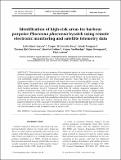Files in this item
Identification of high-risk areas for harbour porpoise Phocoena phocoena bycatch using remote electronic monitoring and satellite telemetry data
Item metadata
| dc.contributor.author | Kindt-Larsen, Lotte | |
| dc.contributor.author | Willestofte Berg, Casper | |
| dc.contributor.author | Tougaard, Jakob | |
| dc.contributor.author | Kirk Sørensen, Thomas | |
| dc.contributor.author | Geitner, Kerstin | |
| dc.contributor.author | Northridge, Simon Patrick | |
| dc.contributor.author | Sveegaard, Signe | |
| dc.contributor.author | Sveegaard, Signe | |
| dc.contributor.author | Larsen, Finn | |
| dc.date.accessioned | 2021-08-17T23:37:42Z | |
| dc.date.available | 2021-08-17T23:37:42Z | |
| dc.date.issued | 2016-08-18 | |
| dc.identifier | 244842177 | |
| dc.identifier | 14023b08-d27c-4af7-a128-f4c82067645d | |
| dc.identifier | 84983757505 | |
| dc.identifier | 000383801600018 | |
| dc.identifier.citation | Kindt-Larsen , L , Willestofte Berg , C , Tougaard , J , Kirk Sørensen , T , Geitner , K , Northridge , S P , Sveegaard , S , Sveegaard , S & Larsen , F 2016 , ' Identification of high-risk areas for harbour porpoise Phocoena phocoena bycatch using remote electronic monitoring and satellite telemetry data ' , Marine Ecology Progress Series , vol. 555 , pp. 261-271 . https://doi.org/10.3354/meps11806 | en |
| dc.identifier.issn | 0171-8630 | |
| dc.identifier.other | ORCID: /0000-0002-7402-3462/work/48131919 | |
| dc.identifier.uri | https://hdl.handle.net/10023/23791 | |
| dc.description.abstract | ABSTRACT: The bycatch of harbour porpoise Phocoena phocoena is an issue of major concern for fisheries management and for porpoise conservation. We used high-resolution spatial and temporal data on porpoise abundance and fishing effort from the Danish Skagerrak Sea to identify areas with potentially higher and lower risk of porpoise bycatch. From May 2010 to April 2011, 4 commercial gillnet vessels were equipped with remote electronic monitoring (REM) systems. The REM system recorded time, GPS position and closed-circuit television (CCTV) footage of all gillnet hauls. REM data were used to identify fishing grounds, quantify fishing effort and document harbour porpoise bycatch. Movement data from 66 harbour porpoises equipped with satellite transmitters from 1997 to 2012 were used to model population density. A simple model was constructed to investigate the relationship between the response (number of individuals caught) and porpoise density and fishing effort described by net soak time, net string length and target species. Results showed that a model including both porpoise density and fishing effort data predicted bycatch better than models containing only one factor. We therefore conclude that porpoise telemetry or REM data allow for identification of areas of potential high and low bycatch risk, and better predictions are obtained when combining the 2 sources of data. The final model can thus be used as a tool to identify areas of bycatch risk. | |
| dc.format.extent | 11 | |
| dc.format.extent | 669665 | |
| dc.language.iso | eng | |
| dc.relation.ispartof | Marine Ecology Progress Series | en |
| dc.subject | Harbour porpoise | en |
| dc.subject | Bycatch mitigation | en |
| dc.subject | REM | en |
| dc.subject | Natura 2000 | en |
| dc.subject | Fisheries management | en |
| dc.subject | QH301 Biology | en |
| dc.subject | SDG 14 - Life Below Water | en |
| dc.subject.lcc | QH301 | en |
| dc.title | Identification of high-risk areas for harbour porpoise Phocoena phocoena bycatch using remote electronic monitoring and satellite telemetry data | en |
| dc.type | Journal article | en |
| dc.contributor.sponsor | European Commission | en |
| dc.contributor.institution | University of St Andrews. School of Biology | en |
| dc.contributor.institution | University of St Andrews. Sea Mammal Research Unit | en |
| dc.contributor.institution | University of St Andrews. Scottish Oceans Institute | en |
| dc.identifier.doi | 10.3354/meps11806 | |
| dc.description.status | Peer reviewed | en |
| dc.date.embargoedUntil | 2021-08-18 | |
| dc.identifier.grantnumber | 289257 | en |
This item appears in the following Collection(s)
Items in the St Andrews Research Repository are protected by copyright, with all rights reserved, unless otherwise indicated.

